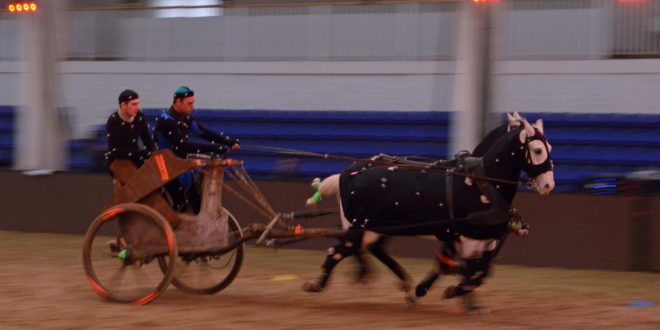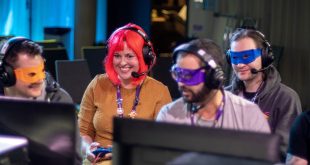Motion capture, or simply mocap, remains a challenging, multi-skilled discipline. A unique blend of high-end technology, software expertise, real-world construction, plus human performance ranging from a mere raised eyebrow to a double backflip off a tower. And that’s a blend that Audiomotion MD Brian Mitchell still relishes, he tells MCV: “The thing I love most is being in the studio and being involved.”
With a huge studio space, numerous skilled staff and no fewer than 160 cameras, Audiomotion’s operation doesn’t look like the kind of thing which your average indie developer could raise the money to utilise. However, Mitchell is keen to discuss how smaller outfits can still make good use of professional mocap at reasonable budgets.
PUTTING A PRICE ON IT
“I think there’s a general perception that mocap is expensive,” Mitchell admits, though he’s cautious not to name figures for a day in the studio, and for good reason. “Everyone wants to know your figures without giving you any information. I can’t really give you a price without knowing what you’re trying to do, there’s a lot of variables.”
When you have a business that one day is capturing a single performer’s facial movements, and the next has a full F1 pit crew doing tire changes on a real F1 car, you can see the truth of that statement. Of course most smaller projects will be nearer the former than the latter, but even then expectations need to be carefully managed on how much can be achieved in a day. For first-time users a test shoot is often the best option.
“We’ll do a half day shoot, capture some moves relevant to project, put them together as a little package – we take them through the whole process, prove the pipeline, they get deliverables and get to see how it all works before they invest in going all out,” Mitchell explains.
Audiomotion charges for such test shoots, otherwise they’d “get a lot of people who kick tires.” But once “they’ve demonstrated that they’re serious” the company will discount the cost of that initial shoot off that of further work. “You can always tailor a budget to suit people,” he states.
Another way to keep costs down is to be flexible. Audiomotion works with names as big as Disney and Guerrilla, but there’s always odd spaces between the big projects to fit in smaller shoots.
“As with production in any form, dates slip and very often we’ll have dates pencilled, regular clients put a date in as a marker, but that’s likely to get bumped a couple of times,” Mitchell says. “But you know it’s out there. And when they’re ready they’ll give you an update.”
But that also means the studio can be available at fairly short notice for those with the flexibility to take advantage: “If they can be flexible on when the studio and the talent is available then we can make it work. You don’t want to scare off the little guys.”
And as Mitchell explains to us, Audiomotion’s own reputation benefits from being involved with exciting projects, be they big or small: “[Indie] projects have just as much potential as the big stuff.”
MoCAT
In its 21 years in operation, Audiomotion has taken on some pretty epic projects. And things are still growing and evolving. Mitchell returns to that F1 pit crew they had in recently for Codemasters. Audiomotion suited up the entire crew, who came in complete with all the kit for their high-speed mechanical work. And while that’s a big and complex capture job, there are some upsides to recreating real-world events.
“They’re experts at what they do, so of course they didn’t have to rehearse,” Mitchell recalls. They know how to work on the car and they execute it perfectly. Years before Mitchell tells us that the same shoot was done “with just one person, doing the role of every single person in the crew.”
Sometimes you have to get out of the studio to get the best results, he adds: “We’ve done big football shoots, a dozen guys playing out various moves on a 3G training ground at Crystal Palace.” And with all those players, there’s lots of occlusion, where players block the cameras’ view, “so that’s a very high camera count,” Mitchell explains.
Back in the studio, “we’ve done quite a lot of horses, rearing up, galloping, we’ve done chariots even. And various dogs, we’ve even done a cat.”
Dogs we can see, but finding a well-trained cat can’t be easy? “I don’t think there’s such a thing as a well-trained cat,” Mitchell replies with a wry smile.
It might be nigh-on impossible to direct a cat, but most performers work best with someone taking charge of their performance: a director.
“Some developers have a lead animator who is basically put in a position of directing actors,” Mitchell tells us. “But the biggest challenge is that actors have a certain language, to communicate the emotional state of the character for instance.”
If the developer doesn’t have that skill set then Audiomotion will bring in an assistant director to help the team. Plus the assistant director can also help the shoot move along smoothly, giving the animator time to concentrate on what they need. Another option is to get talent who really knows the process.
“We can bring in a lead actor with more ability to self-direct and experience with bigger projects,” Mitchell says. Either way, it’s this kind of experience that can really help in the direction of a mocap shoot.
REMOTE WORKING
All that said, these days it’s not even strictly necessary to be present in order to direct some mocap shoots. “When we did Kingsglaive: Final Fantasy XV, we had a director in Japan reviewing data as we captured it,” Mitchell explains.
That’s thanks to the company’s web app, which lets anyone – whether they’re in the studio or in Japan – look at the takes being shot and select the best ones.
“A lot of people just work with an Excel spreadsheet of shots, but this application gives you three live action videos time-synced with the data, and you get real-time pre-vis,” Mitchell says. “What you can do is scrub through this, mark in-and-out points, give it a name, and put it in a shopping cart effectively.
“If you capture a couple of hundred takes, you can mark that as a preferred take as you capture, we load in your shot list and all the descriptions get filled in as you go. That’s useful for anybody.”
Even if there is development staff on the set, then the ability to quickly share what’s being captured with others back at the office is incredibly useful – particularly on larger projects with many stakeholders in the production pipeline. And you don’t need to be halfway around the world to benefit.
“We’ve had guys in Glasgow who don’t want to travel down and just need a small amount of data, so they can do it remotely, using a webcam and this application,” Mitchell continues. “We’re shooting it, they can watch it via webcam, give some feedback. It’s a little bit of a slower process, but they get what they need.”
And all without spending a whole day travelling.
HOME MOVIES
Of course, why use a mocap studio at all if you can do it in your own office?
“There’s lots more people buying their own kit, especially the bigger names,” Mitchell admits. “And that’s great for prototyping, trying things out, capturing generic stuff – because you don’t want to go to a studio to shoot that, that makes sense,” he admits.
However there’s a lot of things that most developers will struggle to create in their own space: “We did one shoot where we had a mansion house with two flights of stairs and a landing, with actors on every layer, and that’s quite a structure to put on inside a mocap volume,” he recalls.
And then there’s the sheer experience that an established mocap studio brings: “Because we’ve been doing it for so long, and people know we’ve been doing it for so long, we’re in a position where we can advise people and they listen. That’s probably one of our strongest features, the experience and knowledge we can bring to the process,” Mitchell says. “As with any service, you’ve got to adapt with the market, the environment and technology.”
Pre-visualisation, especially via Unity and Unreal, has become pretty standard in the industry for instance, giving animators a far better idea of what the finished product will look like while working in the studio.
“The software has moved on, to enable us all to let lots of different pieces of kit talk to each other, to present something much more complete,” he says.
And it’s something complete that a mocap studio can offer. While the technology is more widely available and easier to use, the construction of sets, outdoor shoots, finding the right talent, and directing it properly, are all elements which can be hard for a typical animation lead to master. “The interesting bit for me is solving problems, people coming up with a conundrum, and us coming up with a creative solution,” Mitchell concludes.

 MCV/DEVELOP News, events, research and jobs from the games industry
MCV/DEVELOP News, events, research and jobs from the games industry




